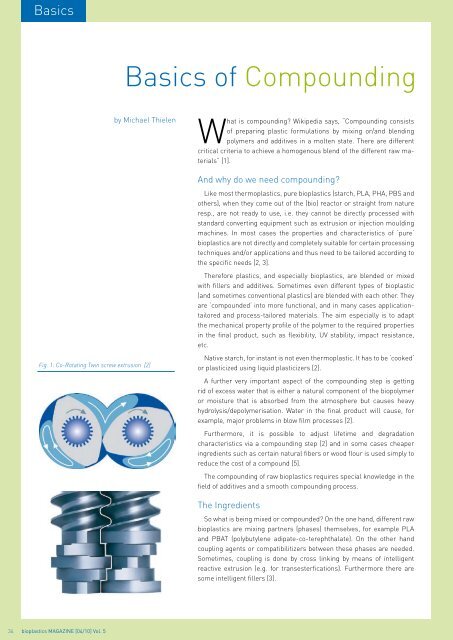04 | 2010
Create successful ePaper yourself
Turn your PDF publications into a flip-book with our unique Google optimized e-Paper software.
Basics<br />
Basics of Compounding<br />
by Michael Thielen<br />
Fig. 1: Co-Rotating Twin screw extrusion [2]<br />
What is compounding? Wikipedia says, “Compounding consists<br />
of preparing plastic formulations by mixing or/and blending<br />
polymers and additives in a molten state. There are different<br />
critical criteria to achieve a homogenous blend of the different raw materials“<br />
[1].<br />
And why do we need compounding?<br />
Like most thermoplastics, pure bioplastics (starch, PLA, PHA, PBS and<br />
others), when they come out of the (bio) reactor or straight from nature<br />
resp., are not ready to use, i.e. they cannot be directly processed with<br />
standard converting equipment such as extrusion or injection moulding<br />
machines. In most cases the properties and characteristics of ‘pure‘<br />
bioplastics are not directly and completely suitable for certain processing<br />
techniques and/or applications and thus need to be tailored according to<br />
the specific needs [2, 3].<br />
Therefore plastics, and especially bioplastics, are blended or mixed<br />
with fillers and additives. Sometimes even different types of bioplastic<br />
(and sometimes conventional plastics) are blended with each other. They<br />
are ‘compounded‘ into more functional, and in many cases applicationtailored<br />
and process-tailored materials. The aim especially is to adapt<br />
the mechanical property profile of the polymer to the required properties<br />
in the final product, such as flexibility, UV stability, impact resistance,<br />
etc.<br />
Native starch, for instant is not even thermoplastic. It has to be ‘cooked‘<br />
or plasticized using liquid plasticizers [2].<br />
A further very important aspect of the compounding step is getting<br />
rid of excess water that is either a natural component of the biopolymer<br />
or moisture that is absorbed from the atmosphere but causes heavy<br />
hydrolysis/depolymerisation. Water in the final product will cause, for<br />
example, major problems in blow film processes [2].<br />
Furthermore, it is possible to adjust lifetime and degradation<br />
characteristics via a compounding step [2] and in some cases cheaper<br />
ingredients such as certain natural fibers or wood flour is used simply to<br />
reduce the cost of a compound [5].<br />
The compounding of raw bioplastics requires special knowledge in the<br />
field of additives and a smooth compounding process.<br />
The Ingredients<br />
So what is being mixed or compounded? On the one hand, different raw<br />
bioplastics are mixing partners (phases) themselves, for example PLA<br />
and PBAT (polybutylene adipate-co-terephthalate). On the other hand<br />
coupling agents or compatibilitizers between these phases are needed.<br />
Sometimes, coupling is done by cross linking by means of intelligent<br />
reactive extrusion (e.g. for transesterfications). Furthermore there are<br />
some intelligent fillers [3].<br />
34 bioplastics MAGAZINE [<strong>04</strong>/10] Vol. 5


















